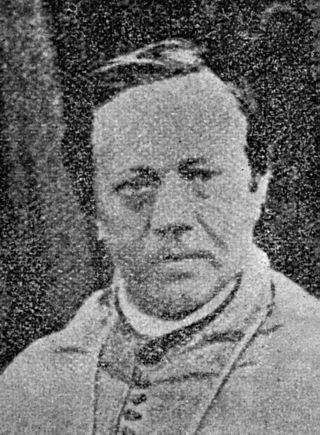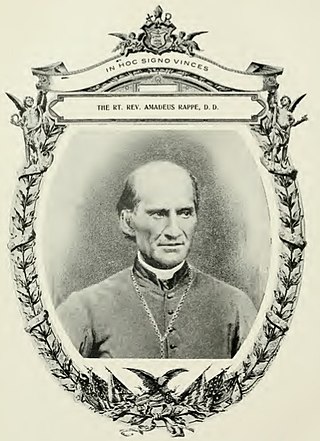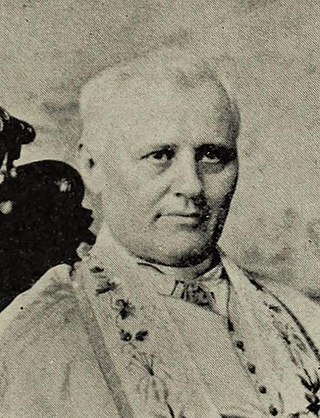
John Baptist Purcell was an American prelate of the Catholic Church. He served as Bishop of Cincinnati from 1833 to his death in 1883, and he was elevated to the rank of archbishop in 1850. He formed the basis of Father Ferrand, the Ohio-based "Irish by birth, French by ancestry" character in the prologue of Willa Cather's historical novel Death Comes for the Archbishop who goes to Rome asking for a bishop for New Mexico Territory.

The Archdiocese of Cincinnati is a Latin Church ecclesiastical jurisdiction, or archdiocese, of the Catholic Church that covers many dioceses throughout the State of Ohio in the United States.

The Catholic Telegraph is a monthly magazine published by the Roman Catholic Archdiocese of Cincinnati primarily for its 500,000 congregants. The archdiocese covers 19 counties in Ohio, including the Cincinnati and Dayton metropolitan areas. Originally a weekly newspaper, the Telegraph has published continuously since 1831, except for a brief period in 1832, making it the first diocesan newspaper and second oldest Catholic newspaper in the United States. The Telegraph became a monthly newspaper in September 2011 and began publishing in magazine format in June 2020.

During the American Civil War, the State of Ohio played a key role in providing troops, military officers, and supplies to the Union army. Due to its central location in the Northern United States and burgeoning population, Ohio was both politically and logistically important to the war effort. Despite the state's boasting a number of very powerful Republican politicians, it was divided politically. Portions of Southern Ohio followed the Peace Democrats and openly opposed President Abraham Lincoln's policies. Ohio played an important part in the Underground Railroad prior to the war, and remained a haven for escaped and runaway slaves during the war years.

The Athenaeum of Ohio – Mount St. Mary's Seminary of the West, originally St. Francis Xavier Seminary, is a Catholic seminary in Cincinnati, Ohio. It is the third-oldest Catholic seminary in the United States and was established by Edward Fenwick, the first Bishop of Cincinnati, in 1829 along with The Athenaeum, which opened in 1831 in downtown Cincinnati.

John Henry Luers was an American prelate of the Roman Catholic Church. He served as the first bishop of the new Diocese of Fort Wayne in Indiana from 1858 until his death in 1871.
The Sisters of Charity of Cincinnati were founded in 1852 by Mother Margaret Farrell George, by the separation of the community from the Sisters of Charity in Emmitsburg, Maryland. the motherhouse of the community is at Mount Saint Joseph, Ohio.

John Martin Henni was a Swiss-born prelate of the Roman Catholic Church who served as the first Archbishop of the Archdiocese of Milwaukee, Wisconsin from 1843 until his death in 1881.

Augustus Maria Bernard Anthony John Gebhard Toebbe was a German-born American prelate of the Catholic Church. He was the second Bishop of Covington, serving from 1869 until his death in 1884.
The 10th Ohio Infantry Regiment was an infantry regiment in the Union Army during the American Civil War. The regiment was also known as the Montgomery Regiment, and the Bloody Tenth. The 10th Ohio Infantry was predominantly recruited from Irish Americans, but had two companies consisting of German Americans.
Joseph H. Albers D.D. was an American prelate of the Roman Catholic Church. Albers served as the first bishop of the new Diocese of Lansing in Michigan in from 1937 until his death in 1964. He served as an auxiliary bishop of the Archdiocese of Cincinnati in Ohio from 1929 until 1937.

Louis Amadeus Rappe was a French-born prelate of the Roman Catholic Church. He served as the first bishop of the new Diocese of Cleveland in Ohio from 1847 to 1870.

Sylvester Horton Rosecrans was an American prelate of the Roman Catholic Church. He served as bishop of the Diocese of Columbus in Ohio from 1868 until his death in 1878. He previously served as an auxiliary bishop of the Archdiocese of Cincinnati in Ohio from 1862 to 1868.

Henry Damian Juncker was a French-born prelate of the Roman Catholic Church. He was the first bishop of the Diocese of Alton in Illinois, serving from 1857 until his death in 1868.

Richard Gilmour was a Scottish-born Catholic prelate who served as Bishop of Cleveland from 1872 until his death in 1891.

Thomas Sebastian Byrne was an American prelate of the Catholic Church. He served as bishop of the Diocese of Nashville in Tennessee from 1894 until his death in 1923.

Gilbert Ignatius Sheldon was an American prelate of the Roman Catholic Church. He served as the third bishop of the Diocese of Steubenville in Ohio between 1992 and 2002. Sheldon previously served as an auxiliary bishop of the Diocese of Cleveland in Ohio from 1976 to 1992.

Anthony Durier was a French-born American prelate of the Catholic Church. He served as the third bishop of the Diocese of Natchitoches in Louisianan from 1885 until his death in 1904.

St. Mary's on the Flats, originally known as the Church of Our Lady of the Lake, was the first Catholic church building in Cleveland, Ohio. The location where the church once stood can be found, in an 1881 atlas, at the south-east corner of Columbus Ave. and then Girard Ave. on the east bank of the Cuyahoga river in the flats. Irishtown Bend Archeological District, where many of the parishioners lived, lies to the west, across the Cuyahoga river in what was Ohio City. Ohio City was annexed by Cleveland on June 5, 1854.
William O'Higgins (1794-1853), was an Irish Roman Catholic priest and professor, who served as Bishop of Ardagh and Clonmacnoise, from 1829 until his death in 1853.















